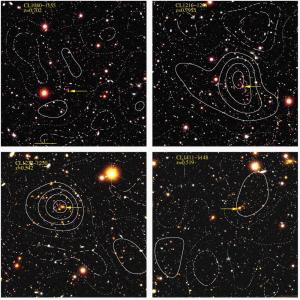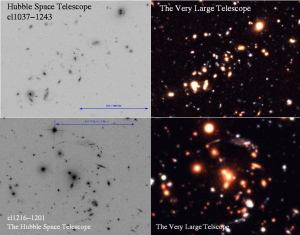
|
Fig. 1:
These four images show color images of the field around four
clusters at different redshifts and with different masses. The
brightest galaxy in each cluster is identified by the yellow arrow,
and the cluster itself can be seen as an abundance of red galaxies
around the brightest member. The white contours indicate lines of
constant mass surface density in each cluster, as determined by a
gravitational lensing analysis. In these plots, many concentric lines
indicate a high mass. Although both clusters are comprised of many
galaxies, only two of them have strong signals, demonstrating the
large range of properties in our sample.
|
|
 |
Galaxy clusters are the most massive quasi-equilibrium objects in the
Universe and are the meeting places of the cosmos. Their deep
potential wells are dominated by unseen dark matter, but contain a
cosmologically representative baryon fraction in the form of galaxies
and intergalactic gas. These are trapped in a virialized state, with
the gas heated to tens of millions of degrees and the galaxies moving
with typical velocities of approximately 1000 km/s. Because of their
extreme environments, clusters are ideal places to study how galaxies
are affected by their surroundings, namely through galaxy
interactions and through the collision with the cluster gas. At the
same time, by observing clusters when the Universe was half its
present age the astronomers can see how the galaxies in them have
changed with time.
The research group is leading a project to address these issues. The
ESO Distant Cluster Survey ( EDisCS) consists
of detailed observations of 20 clusters spread over a redshift range
of 0.45 < z < 0.8. The observations were performed with two telescopes
in Chile; 36 nights of observations were performed with the Very
Large Telescope ( EDisCS) consists
of detailed observations of 20 clusters spread over a redshift range
of 0.45 < z < 0.8. The observations were performed with two telescopes
in Chile; 36 nights of observations were performed with the Very
Large Telescope ( VLT)
on Paranal and 20 nights were
performed with the New Technology Telescope ( VLT)
on Paranal and 20 nights were
performed with the New Technology Telescope ( NTT) on La Silla. NTT) on La Silla.
One main result at this early stage is that the EDisCS clusters
appear to have a large range in mass (see Figure 1) where the mass of
the clusters has been directly measured using an effect called weak
gravitational lensing. This effect measures correlations between the
orientation of background galaxies that are caused when their light
passes through the gravitational potential of the foreground cluster.
The advantage of this technique is that it measures the total mass in
each cluster, including the dark matter. While some of the clusters
are among the most massive at their distance, some are have such a
low mass that they cannot be detected with the weak gravitational
lensing technique.
|


